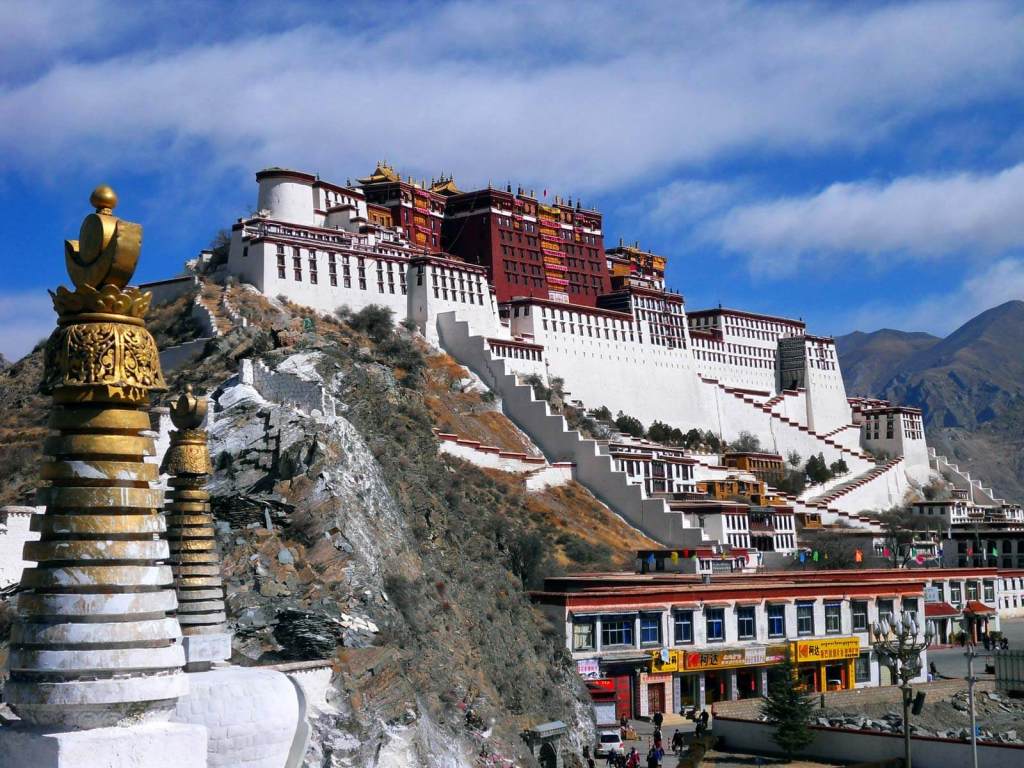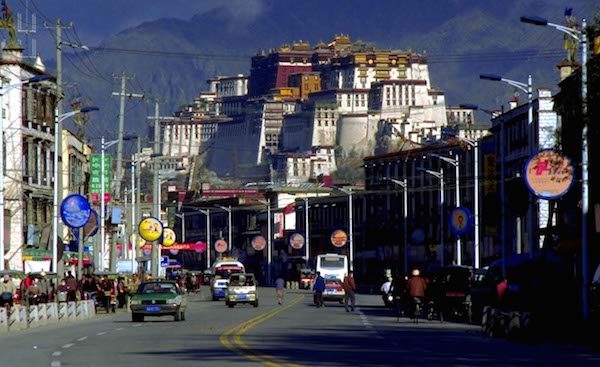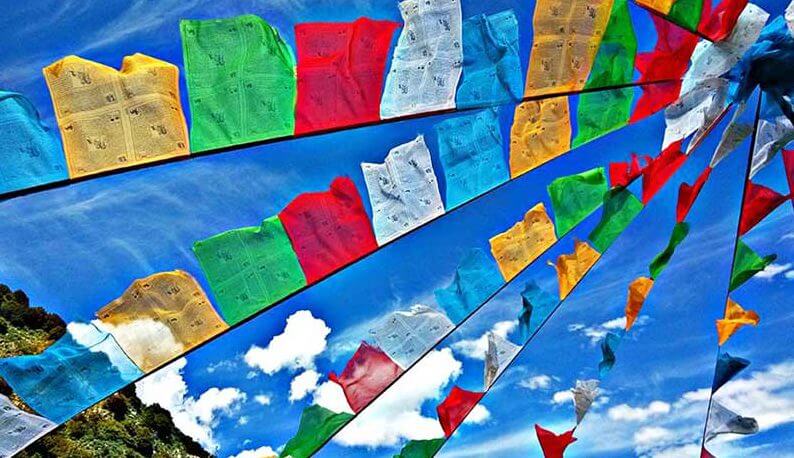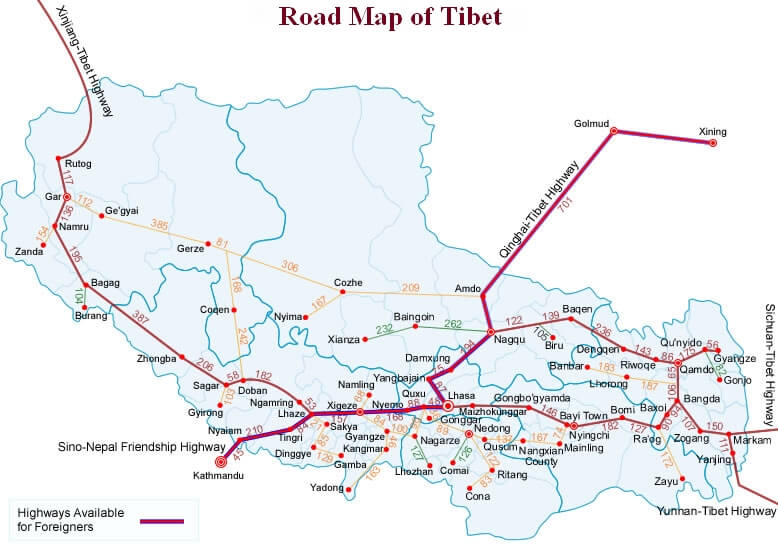Sinicization of Tibet is a phrase which is used for Chinese rule in Tibet in reference to the cultural assimilation which has occurred in Tibetan areas of China (including the Tibet Autonomous Region and surrounding Tibetan-designated autonomous areas) and has made these areas resemble mainstream Chinese society. The changes, which have been evident since the incorporation of Tibet into the People’s Republic of China in 1950–51, have been facilitated by a range of economic, social, cultural, religious and political reforms which have been introduced to Tibet by the Chinese government. The government-sponsored migration of large numbers of Han Chinese into the TAR is a major component of sinicization.

Early Chinese Political Moves
After the fall of the Qing dynasty and before 1950, the region which roughly corresponds to the modern-day Tibet Autonomous Region (TAR) was a de facto independent nation. It printed its own currency and postage, and maintained international relations. Tibet claimed three provinces (Amdo, Kham and Ü-Tsang), but only controlled western Kham and Ü-Tsang. Since 1950, China made eastern Kham part of Sichuan and western Kham part of the new TAR.

During the early-20th-century Republic of China era which followed the Qing dynasty, Chinese Muslim general and Qinghai governor Ma Bufang is accused by Tibetans of implementing sinicization and Islamification policies in Tibetan areas. Forced conversion and heavy taxes were reported under his rule. After Mao Zedong won the Chinese civil war in 1949, his goal was the unification of the “five nationalities” as the People’s Republic of China under the Communist Party of China. The Tibetan government in Lhasa sent their Leader Ngabo to Chamdo in Kham, a strategic town near the border, with orders to hold his position while reinforcements came from Lhasa to fight the Chinese. On 16 October 1950, news arrived that the People’s Liberation Army (PLA) was advancing towards Chamdo and had taken the town of Riwoche, which could block the route to Lhasa. Ngabo and his men retreated to a monastery, where the PLA surrounded and captured them. Ngabo wrote to Lhasa suggesting a peaceful surrender instead of war. According to the Chinese negotiator, “It is up to you to choose whether Tibet would be liberated peacefully or by force. It is only a matter of sending a telegram to the PLA group to recommence their march to Lhasa.” Ngabo accepted Mao’s Seventeen-Point Agreement, which stipulated that in return for Tibet becoming part of the People’s Republic of China, it would be granted autonomy. Lacking support from the rest of the world, in August 1951 the Dalai Lama sent a telegram to Mao accepting the agreement. The delegates signed the agreement under duress, and the Tibetan’s government’s future was sealed.

Although the incorporation of Tibet into China is known in Chinese historiography as the Peaceful Liberation of Tibet, the Dalai Lama considers it a colonization, and the Tibetan Youth Congress agrees that it was also an invasion. The Chinese government points to improvements in health and the economy as justifications for their assertion of power in what it calls a historically-Chinese region. According to the Dalai Lama, China has encouraged Han Chinese immigration into the region. Before the agreement, Tibet’s economy was dominated by subsistence agriculture and the stationing of 35,000 Chinese troops during the 1950s strained the region’s food supplies. When the Dalai Lama visited Mao Zedong in Beijing in 1954, Mao told him that he would move 40,000 Chinese farmers to Tibet. As part of the 1960s Great Leap Forward, Chinese authorities coerced Tibetan farmers to cultivate maize instead of barley (the region’s traditional crop). The harvest failed, and thousands of Tibetans starved.

Ethnic Minorities in China
China officially recognizes 55 ethnic minority groups within China in addition to the Han majority. The minorities are located primarily in the south, west, and north of China. the combined population of officially recognized minority groups comprised 8.49%. Only Tibet Autonomous Region and Xinjiang Uygur Autonomous Region have a majority population of official minorities, while all other provinces, municipalities and regions of China have a Han majority. Much of the dialog within China regarding minorities has generally portrayed minorities as being further behind the Han in progress toward modernization and modernity. Minority groups are often portrayed as rustic, wild, and antiquated. As the government often portrays itself as a benefactor of the minorities, those less willing to assimilate (despite the offers of assistance) are portrayed as masculine, violent, and unreasonable. Groups that have been depicted this way include the Tibetans, Uyghurs and the Mongols.

Tibet Autonomous Region (TAR)
The TAR is an autonomous region formally established in 1965 to replace the Tibet Area, an administrative division of China. Tibet was incorporated into PRC in 1951. The Tibet Autonomous Region is the second-largest province-level division of China by area, spanning over 1,200,000 km2 , second only to Xinjiang. It is the least densely populated provincial-level division of the PRC. There is a politically-charged historical debate on the exact nature of Sino-Tibetan relations. Most historians agree that Tibet was an independent State during the Chinese Ming dynasty and that the Manchu Qing dynasty (1644-1911) had established protectorate over Tibet after the Mongol conquest of Tibet and Yuan administrative rule in the 13th and 14th centuries. Qing dynasty (1636–1912) rule in Tibet began with their 1720 expedition to the country when they expelled the invading Dzungars and Tibet was actually first controlled by central government. From 1912 to 1950 Tibet was under de jure suzerainty of the Republic of China. In 1950, the People’s Liberation Army marched into Tibet and defeated the Tibetan local army in a battle fought near the city of Chamdo. In 1951, the Tibetan representatives signed a 17-point agreement with the Central People’s Government affirming China’s sovereignty over Tibet and the incorporation of Tibet. The agreement was ratified in Lhasa a few months later. Although the 17-point agreement had provided for an autonomous administration led by the Dalai Lama, a “Preparatory Committee for the Autonomous Region of Tibet” (PCART) was established in 1955 to exclude the Dalai Lama’s government and create a system of administration along Communist lines. Under threat of his life from Chinese forces the Dalai Lama fled to India in 1959 and renounced the 17-point agreement. Tibet Autonomous Region was established in 1965, thus making Tibet a provincial-level division of China. TAR ethnic composition is 90 percent Tibetan, and 8 per cent Han, and remaining others. With an average of only two people per square kilometer, Tibet has the lowest population density among any of the Chinese province-level administrative regions, mostly due to its harsh and rugged terrain.

Human Rights Issues in Tibet
Before the People’s Liberation Army invasion of Tibet in 1951, Tibet was ruled by a theocracy and had a caste-like social hierarchy. Due to tight control of press in mainland China, including the Tibet Autonomous Region, it is difficult to accurately determine the scope of human rights abuses. The Chinese Communist Party (CCP) in the garb of eliminate “the three evils of separatism, terrorism and religious extremism” is known to perpetuate human rights abuses. A 1992 Amnesty International report stated that judicial standards in the TAR were not up to “international standards”. The report charged the CCP government with keeping political prisoners and prisoners of conscience; ill-treatment of detainees, including torture, and inaction in the face of ill-treatment; the use of the death penalty; extrajudicial executions; and forced abortion and sterilization.

Cultural Revolution
During the Cultural Revolution, from 1966 to 1976 Tibet suffered as a result. Red Guards attacked civilians, who were accused of being traitors to communism. More than six thousand monasteries were looted and destroyed. Monks and nuns were forced to leave their monasteries to “live a normal life”, with those who resisted imprisoned. Prisoners were forced to perform hard labor, tortured and executed. Although the Potala Palace was threatened, Premier Zhou Enlai intervened and restrained the Tibetan Red Guards.

Choosing the Next Dalai Lama
The Chinese government claims it will control how the 15th Dalai Lama will be chosen, contrary to centuries of tradition. Chinese government officials repeatedly warn “that he must reincarnate, and on their terms.” When the Dalai Lama confirmed a Tibetan boy in 1995 as the reincarnation of the Panchen Lama, the second-ranking leader of the Gelugpa sect, the Chinese government took away the boy and his parents and installed its own child lama. The Dalai Lama’s choice, Gedhun Choekyi Nyima’s whereabouts are still unknown. The Chinese government claimed he has “a stable job and a “normal” life. In 2020 US Secretary of State Mike Pompeo said in a statement that “Tibetan Buddhists, like members of all faith communities, must be able to select, educate and venerate their religious leaders according to their traditions and without government interference,” “We call on the PRC government to immediately make public the Panchen Lama’s whereabouts and to uphold its own constitution and international commitments to promote religious freedom for all persons.”

Direct Religious Interference and Clampdown
Within Tibet, schools issue warnings to parents that students should not be attending classes at monasteries, a long-standing tradition, or engage in any religious activity. Punishments for doing so are severe, including loss of government welfare and subsidies.

The practice of removing prayer flags, symbols of Tibetan culture and religious belief, has increased since 2010 as the persecution of religion escalates. In June 2020 Chinese authorities started a “behavioral reform,” program, begun in the TAR’s Qinghai’s Golog (in Chinese, Guoluo) and Tengchen (Dingqing) county in Chamdo, ordering the destruction of prayer flags. The 2019 Tibetan Centre for Human Rights and Democracy annual report found that Chinese police forces and surveillance teams moved into monasteries and villages to monitor Tibetan residents for signs of opposition to China’s rule, “facial-recognition software and careful monitoring of digital spaces were deployed to suppress political protests against the increased clampdowns on civil and political rights.”

During the summer of 2019, China authorities demolished thousands of residences at the Yachen Gar Tibetan Buddhist center in Sichuan Province, displacing as many as 6,000 monks and nuns. In April 2019, China authorities closed the Larung Gar Buddhist Academy to new enrollment. Authorities also intensified a crackdown on possessing or displaying photos of the Dalai Lama, continued to monitor religious festivals, and, in some areas, banned students from attending festivals during their school holidays. In protest of repressive government policies, at least 156 Tibetans have self-immolated since February 2009.

Indoctrinating Children – Special Boarding Schools
Tibetan neidi or boarding schools, in operation since 1985, have been increasing enrollment rapidly. Tibetan children are removed from their families, and Tibetan religious and cultural influences, and placed in Tibetan only boarding schools across China, well outside the TAR. Older students are allowed to leave the campus only if accompanied by a teacher.

Disavow Allegiance to Dalai Lama for Jobs
Chinese government policy requires only Tibetan government job candidates to disavow any allegiance to the Dalai Lama and support government ethnic policies, as announced in October 2019 on the TAR government’s online education platform, “Support the (Communist) Party’s leadership, resolutely implement the Chinese Communist Party’s line, line of approach, policies, and the guiding ideology of Tibet work in the new era; align ideologically, politically, and in action with the Party Central Committee; oppose any splitting tendencies; expose and criticize the Dalai Lama; safeguard the unity of the motherland and ethnic unity and take a firm stand on political issues, taking a clear and distinct stand.” In April 2020, classroom instruction was switched from Tibetan to Mandarin Chinese in Ngaba, Sichuan.

Nomadic Herders Resettlement
The Chinese government launched an initiative that demanded the nomads to relocate to urban housing in newly constructed villages in 2003. At the end of 2015, in “what amounts to one of the most ambitious attempts made at social engineering, the Chinese government’s campaign to settle the millions of pastoralists who once roamed China’s vast borderlands.” The Chinese government claimed it will have moved the remaining 1.2 million nomad herders into towns that provide access to schools, electricity and modern health care. In 2017 Tibetan nomads previously forced from traditional grazing lands in a state-directed resettlement scheme in Qinghai were told to go back due to a new policy announced in 2016, so authorities could use their current homes for development as tourist centers and government employees housing. “After two years of living in the new towns, residents are now being forced to move back to their original grasslands without their animals, which are the main source of livelihood in Tibetan nomadic communities”.

Han Population Growth
In 1949, there were between 300 and 400 Han-Chinese residents in Lhasa. In 1950, the city covered less than three square kilometres and had around 30,000 inhabitants; the Potala Palace and the village of Zhöl below it were considered separate from the city. In 1992 Lhasa’s permanent population was estimated at a little under 140,000, including 96,431 Tibetans, 40,387 Han-Chinese, and 2,998 Chinese Muslims and others. Added to that figure were 60,000–80,000 temporary residents, primarily Tibetan pilgrims and traders.

Tibet Government in exile – Central Tibetan Administration (CTA)
In 1959, the 14th Dalai Lama fled Tibet and established a government in exile at Dharamsala in northern India. This group claims sovereignty over various ethnically or historically Tibetan areas now governed by China. Aside from the TAR, an area that was administered directly by the Dalai Lama’s government until 1951, the group also claims Amdo (Qinghai) and eastern Kham (western Sichuan). About 45 percent of ethnic Tibetans under Chinese rule live in the TAR, according to the 2000 census. Prior to 1949, much of Amdo and eastern Kham were governed by local rulers and even warlords.

The CTA is recognized by most Tibetans world-wide. The Tibetan Diaspora and refugees support the CTA by voting for members of Parliament, the President and making annual financial contributions through the use of the “Green Book.” Its internal structure is government-like; it has stated that it is “not designed to take power in Tibet”; rather, it will be dissolved “as soon as freedom is restored in Tibet” in favor of a government formed by Tibetans inside Tibet. In addition to political advocacy, it administers a network of schools and other cultural activities for Tibetans in India. On 11 February 1991, the CTA became a founding member of the Unrepresented Nations and Peoples Organization (UNPO) at a ceremony held at the Peace Palace in The Hague, Netherlands.

The Tibetan Government in Exile views current PRC rule in Tibet, including neighboring provinces outside Tibet Autonomous Region, as colonial and illegitimate, motivated solely by the natural resources and strategic value of Tibet, and in gross violation of both Tibet’s historical status as an independent country and the right of Tibetan people to self-determination. It also points to PRC’s autocratic policies, divide-and-rule policies, and what it contends are assimilationist policies, and regard those as an example of ongoing imperialism aimed at destroying Tibet’s distinct ethnic makeup, culture, and identity, thereby cementing it as an indivisible part of China. That said, the Dalai Lama stated in 2008 that he wishes only for Tibetan autonomy, and not separation from China, under certain conditions, like freedom of speech and expression, genuine self-rule, and control over ethnic makeup and migration in all areas claimed as historical Tibet.
According to the government of Tibet in exile, Chinese policy has allegedly resulted in the disappearance of elements of Tibetan culture; this has been called “cultural genocide”. The government in exile says that the policies intend to make Tibet an integral part of China and control desire for Tibetan self-determination. Tibetan language and culture are being systematically reduced in importance.

The view of the current Dalai Lama in 1989 was as follows:
During the 5th Dalai Lama’s time [1617–1682], I think it was quite evident that we were a separate sovereign nation with no problems. The 6th Dalai Lama [1683–1706] was spiritually pre-eminent, but politically, he was weak and uninterested. He could not follow the 5th Dalai Lama’s path. This was a great failure. So, then the Chinese influence increased. During this time, the Tibetans showed quite a deal of respect to the Chinese. But even during these times, the Tibetans never regarded Tibet as a part of China. All the documents were very clear that China, Mongolia and Tibet were all separate countries. Because the Chinese emperor was powerful and influential, the small nations accepted the Chinese power or influence. You cannot use the previous invasion as evidence that Tibet belongs to China. In the Tibetan mind, regardless of who was in power, whether it was the Manchus [the Qing dynasty], the Mongols [the Yuan dynasty] or the Chinese, the east of Tibet was simply referred to as China. In the Tibetan mind, India and China were treated the same; two separate countries.

International Commission of Jurists
For long there was Hollywood celebrity support to the Tibetan movement. The International Commission of Jurists concluded that from 1913 to 1950 Tibet demonstrated the conditions of statehood as generally accepted under international law. In the opinion of the commission, the government of Tibet conducted its own domestic and foreign affairs free from any outside authority, and countries with whom Tibet had foreign relations are shown by official documents to have treated Tibet in practice as an independent State. The United Nations General Assembly passed resolutions urging respect for the rights of Tibetans in 1959, 1961, and 1965. The 1961 resolution calls for that “principle of self-determination of peoples and nations” applies to the Tibetan people.

Tibetan sovereignty debate
The Tibetan sovereignty debate refers to two political debates. The first is whether the various territories within the People’s Republic of China (PRC) that are claimed as political Tibet should separate and become a new sovereign state. Many of the points in the debate rest on a second debate, about whether Tibet was independent or subordinate to China in certain parts of its recent history. It is generally held that China and Tibet were independent prior to the Yuan dynasty (1271–1368), and that Tibet has been ruled by the People’s Republic of China (PRC) since 1959. The nature of Tibet’s relationship with China in the intervening period is a matter of debate. China asserts that Tibet has been a part of China since the Mongol Yuan dynasty. The Tibetan Government in Exile asserts that Tibet was an independent state until the PRC invaded Tibet in 1949/50. Some Western scholars maintain that Tibet and China were ruled by the Mongols during the Yuan dynasty, that Tibet was independent during the Chinese Ming dynasty (1368–1644), and that Tibet was ruled by China or at the very least subordinate to the Manchu Qing during much of the Qing dynasty. Some Western scholars also maintain that Tibet was independent from c. 1912 to 1950. although it had extremely limited international recognition.
To Summarise and Security Implications – India
The process of Sinicization of Tibet is continuing unabated. China has made huge road and rail infrastructure to exercise greater control over the population and also for security of the region. How history unfolds is difficult to predict. Tibetan culture and traditions have to be kept alive with the support of Tibetans in Exile. Local Tibetan leaders in TAR have to be careful about Chinese financial inducements. The world has to keep a watch and check on Chinese expansionist plans, because they are at the detriment to international norms and sovereignty. Tibetans require global support for reclaiming their land, religion and cultural heritage.

Traditionally Tibet was a buffer state between China and India. Chinese heavy presence in TAR has security implications for India. Parts of India in the Aksai Chin, Himachal Pradesh and Arunachal are being claimed by the Chinese in the garb of they being part of Tibet as per them. China is also building connectivity with Nepal through the mighty Himalayas. It shall be in India’s geopolitical interest that Tibet becomes independent or had high level autonomy.


If war breaks out because of the current Indo-Sino border stand-off, can India take the fight to Tibet and liberate it?
LikeLike
That is too far fetched currently. But remember Histories and geographies change over time.
LikeLike
I hope that war breaks out so that India can take back CoK [China Occupied Kashmir] and also Tibet. Tibet because the PLA reinforcements for it will have to come from mainland China and that would give India an advantage.
LikeLike
This sinicisation of Tibet is nothing but demographic warfare and law warfare by China which its puppet Pakistan also does in PoK by replacing the Shia Muslim population there with Pakistani Sunni Muslim population.
LikeLike
Thank you for this very informative history lesson. I am a history buff and always like to know the facts.
LikeLike
Geri Lawhon, happy that you enjoyed reading. Thanks for the appreciation. Regards
LikeLiked by 1 person